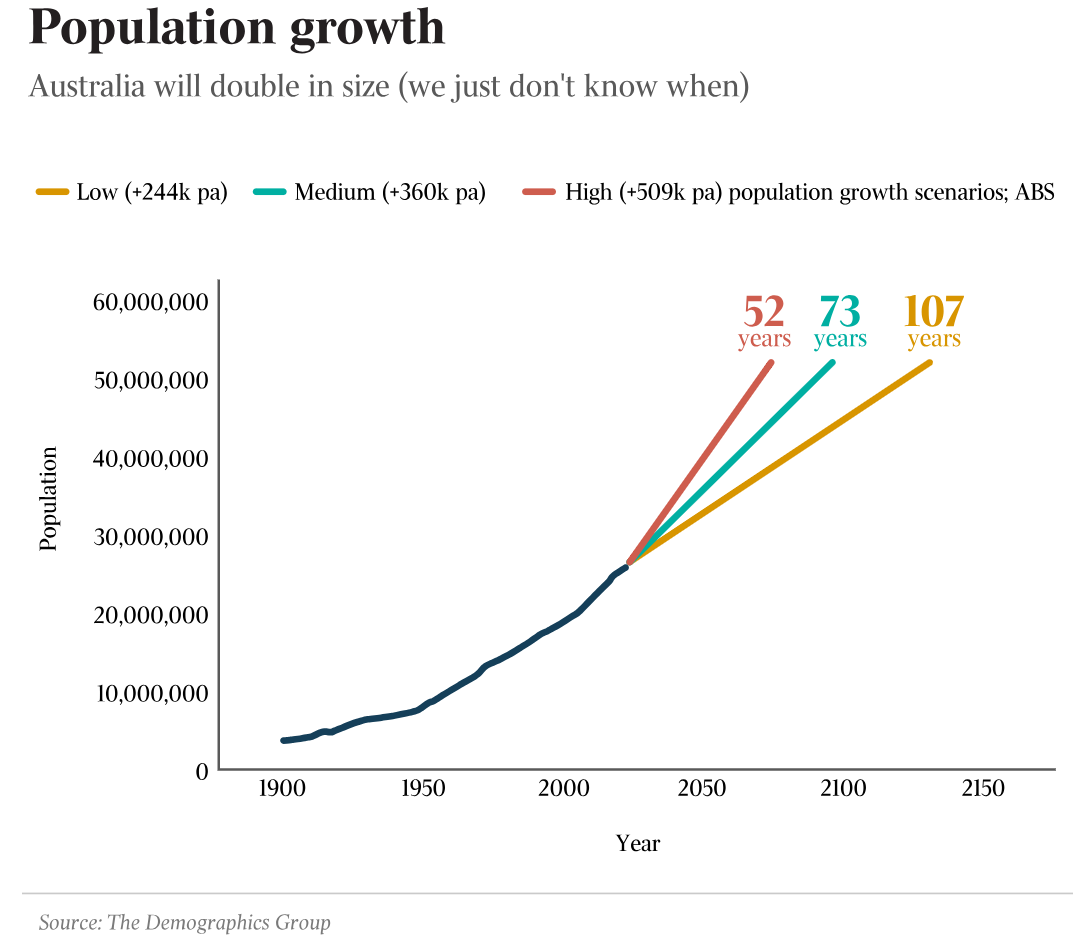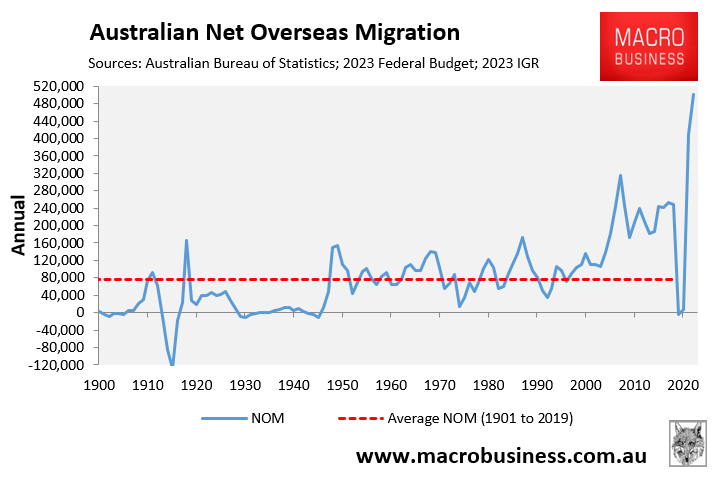Simon Kuestenmacher from The Demographics Group has penned another article spruiking the benefits of a ‘Big Australia’, arguing that it will be key to the nation’s economic success in the years ahead:
“In Australia we create wealth by doing four things very well: Mining, agriculture, international education and tourism. That’s it. That’s what we export”.
“That’s how we achieve a positive trade balance and bring foreign capital into our country”.
“Our simplistic but lucrative national business model guarantees a continuation of the high migration approach, slows efforts of economic diversification, and delivers general wealth and prosperity (at least as soon as we fix housing)”…
“As long as we rely on mining, agriculture, education and tourism we will be operating a high migration regime”…
“For the Australian business model to work we need local workers. A low migration scenario in Australia would necessitate a complete realignment of our national business model:…
“I would therefore argue that, looking 10 to 40 years (or even longer) into the future, the only plausible migration scenario for Australia is a high one”.

As I noted last week, the “business model” described above by Simon Kuestenmacher guarantees falling living standards for Australians.
First, Australia’s mining and agricultural exports are determined by foreign demand and are not labour intensive.
Therefore, importing millions of people via high net overseas migration necessarily dilutes Australia’s mineral wealth and exports among more people, resulting in lower wealth per person (other things being equal).
This brings us to the second part of Australia’s growth model, which relies on funnelling people into low-productivity people-servicing industries in education, hospitality, and the like, while focusing the nation’s productive effort into infrastructure and housing in a bid to keep pace with rapacious population growth.
Australia’s population has expanded by 7.5 million people (40%) this century alone via mass immigration.
However, business investment, infrastructure investment, and housing has failed to keep pace:

In turn, capital stock per worker has shrunk, leading to “capital shallowing” and declining productivity:

Source: Gerard Minack
Congestion costs have also soared as infrastructure has become crush-loaded, further reducing productivity.
As noted by economist Gerard Minack last month:
“Australia’s economic performance in the decade before the pandemic was, on many measures, the worst in 60 years”.
“Per capita GDP growth was low, productivity growth tepid, real wages were stagnant, and housing increasingly unaffordable. There were many reasons for the mess, but the most important was a giant capital-to-labour switch: Australia relied on increasing labour supply, rather than increasing investment, to drive growth”.
“Australia’s population-led growth model was a demonstrable failure in the 15 years prior to the pandemic. Remarkably, the country now seems to be doubling down on the same strategy. The result, unsurprisingly, is likely to be more of the same”.
For a resource-rich nation like Australia, you cannot devise a worse growth model for productivity and living standards.
This brings us to Kuestenmacher’s bogus claim that education is a major export earner for Australia.
In June, Dr Cameron Murray released an explosive report showing how the Australian Bureau of Statistics’ (ABS) international education export figure is “statistical trickery” because the ABS counts all expenditure by somebody on a student visa as an export even if it is funded by income earned while living and working in Australia.
Dr Murray also explained his findings to Sky News. I have likewise debunked the ABS’ bogus education exports figure many times over the past five years.
In reality, most people in Australia on student visas are from low-income nations and immediately start work after arriving in Australia to fund their living and tuition expenses.
This is why we have witnessed many reports of international students struggling to make-ends-meet and having to rely on charities and food banks.
Perversely, this had led to calls for greater taxpayer support for international students.
A significant number of ‘students’ have also enrolled in fake courses in Australia with the intention of permanently living and working here.
The erroneous calculation of international education exports gives the impression that the sector is a major earner for Australia, when in reality most of this “export” income is in fact earned within Australia, which much of it paid to higher education providers as revenue.
In turn, politicians have pandered to the industry by providing work and migration pathways in a bid to grow student numbers and fake “export” volumes.
The reality is that international education was never a genuine “export”.
Instead, they are the key conduit of Australia’s immigration ponzi scheme, which raises housing costs and lowers wages, depressing living standards for the younger and working population.
Rather than continually lowering the quality bar to entice more students into Australia, as suggested by Kuestenmacher, numbers should be curtailed by tightening requirements for admission (both academic and financial), as0 well as restricting employment rights.
Making international students pay for their living expenses and course fees with money earned in their home countries would transform them into legitimate exports and boost their economic value to Australia.
It would also lower student numbers to sensible and sustainable levels, thereby reducing immigration levels, and removing competition for housing and jobs with younger Australians.
Commentators like Kuestenmacher should stop peddling the lie that international education is a large export earner for Australia that the nation should seek to grow.
The reality is the opposite. Australia should seek a lower number of higher quality students that come to Australia to study (not work) and pay their way using money from their home countries.
Kuestenmacher and his ilk should also recognise that extreme population growth is the largest threat to Australia’s natural environment, as explained the by latest State of the Environment Report:

Kuestenmacher also admitted last week that the swelling of Sydney and Melbourne above their efficient size has killed living standards:
“For decades, we ran a migration nation without linking our national housing and migration policies. A rather ridiculous oversight if you ask me”…
“Melbourne and Sydney both stopped functioning seamlessly in their current set-up (one main CBD, low population density, huge urban sprawl) at around 4 million residents”.
Yet, Kuestenmacher still supports the failed ‘Big Australia’ growth model, despite its abject failure.

When you are in an economic hole, Simon Kuestenmacher, stop digging.
Repeating the same failed immigration policy of the recent past and expecting a different result is the definition of insanity.

